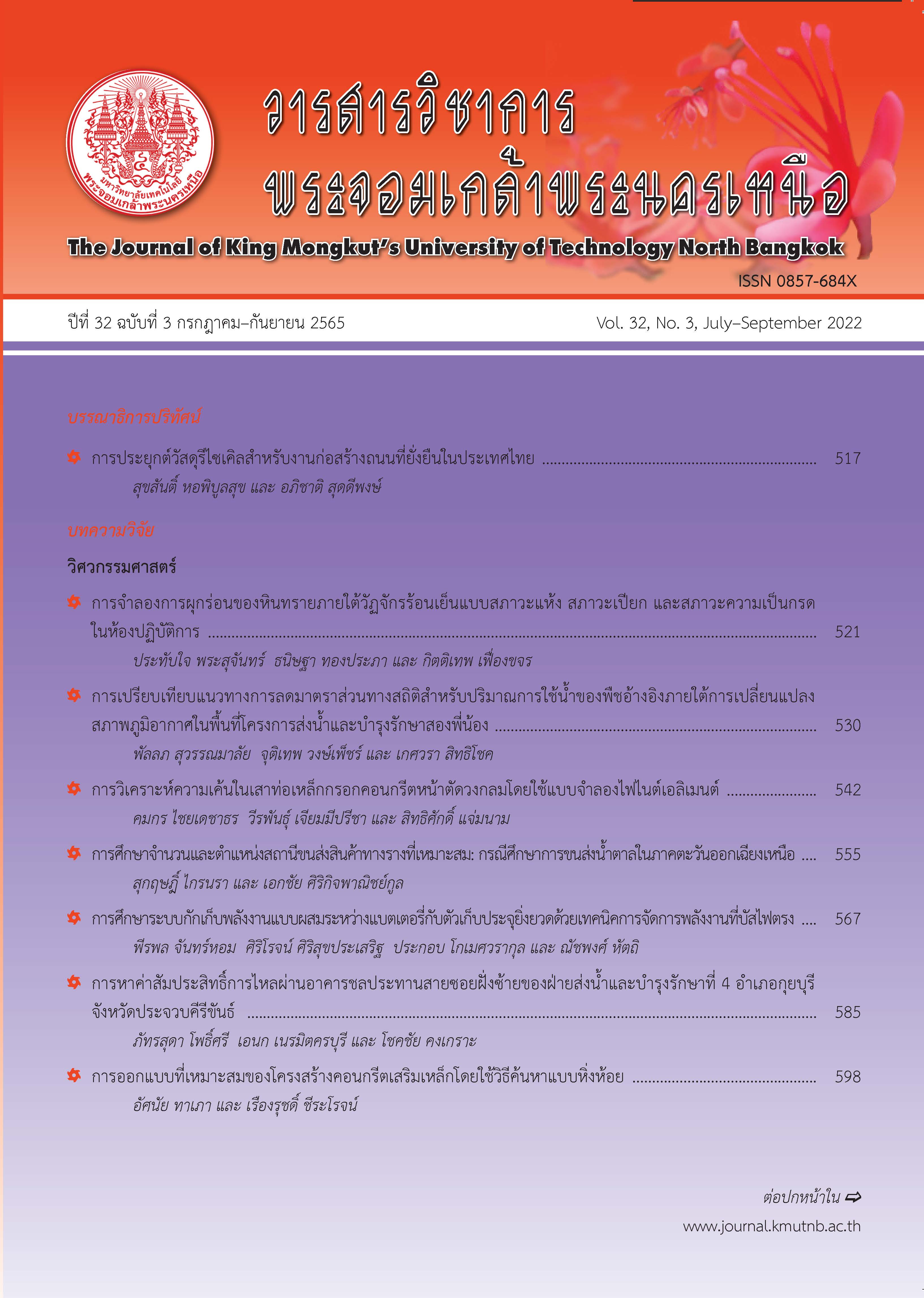ระบบกักเก็บความเย็นในอาคารแบบคอนกรีตมวลเบาร่วมกับสารเปลี่ยนสถานะ
Main Article Content
บทคัดย่อ
งานวิจัยนี้มีแนวคิดในการศึกษาออกแบบระบบกักเก็บความเย็นด้วยสารเปลี่ยนสถานะโดยใช้พลังงานไฟฟ้าจากแผงเซลล์แสงอาทิตย์ (สำหรับปรับอากาศในบ้านที่อยู่อาศัยที่มีการปรับอากาศในช่วงเวลากลางคืน) เพื่อเป็นแนวทางในการพัฒนา ปรับปรุง และเพิ่มประสิทธิภาพของระบบกักเก็บความเย็นในโครงสร้างอาคาร โดยทำการทดสอบประสิทธิภาพของระบบกักเก็บความเย็นด้วยสารเปลี่ยนสถานะประเภท พาราฟิน (อุณหภูมิหลอมละลาย 20 องศาเซลเซียส) ในช่วงการ
กักเก็บความเย็น 5 กรณี (ที่ความถี่คอมเพรสเซอร์ 90 70 60 50 และ 40 เฮิรตซ์) พบว่าความถี่ที่เหมาะสมสำหรับชาร์จความเย็นให้กับสารเปลี่ยนสถานะอยู่ที่ 50 เฮิรตซ์ โดยมีค่าสมรรถนะการทำความเย็น (COP) และอัตราส่วนประสิทธิภาพพลังงาน (EER) อยู่ที่ 3.09 และ 10.53 (Btu/hr.)/W คิดเป็นร้อยละประสิทธิภาพในการกักเก็บความเย็นของระบบเท่ากับ 7.03 การใช้พลังงานไฟฟ้าจากการไฟฟ้าส่วนภูมิภาคเพียงอย่างเดียว มีปริมาณการใช้พลังงานไฟฟ้าอยู่ที่ 6.11 กิโลวัตต์ชั่วโมง (สำหรับการทำความเย็น 8 ชั่วโมง) โดยในกรณีที่มีการใช้พลังงานไฟฟ้าร่วมกับแผงเซลล์แสงอาทิตย์ ทำให้ระบบมีปริมาณการใช้พลังงานไฟฟ้าลดลง อยู่ที่ประมาณ 1.13 กิโลวัตต์ชั่วโมง คิดเป็นร้อยละการประหยัดเท่ากับ 81.57 ซึ่งส่วนประกอบของระบบที่มีการใช้พลังงานไฟฟ้ามากที่สุดได้แก่ ชุดคอยล์ร้อนภายนอกอาคาร คิดเป็นร้อยละ 55
Article Details

อนุญาตภายใต้เงื่อนไข Creative Commons Attribution-NonCommercial-NoDerivatives 4.0 International License.
บทความที่ลงตีพิมพ์เป็นข้อคิดเห็นของผู้เขียนเท่านั้น
ผู้เขียนจะต้องเป็นผู้รับผิดชอบต่อผลทางกฎหมายใดๆ ที่อาจเกิดขึ้นจากบทความนั้น
เอกสารอ้างอิง
Energy Policy and Planning office (EPPO). (2019, October). Energy Situation of First Eight Month of 2018 Report. [Online]. (in Thai). Available: http://www.eppo.go.th/index.php/th/energydata/energysituation/monthly
P. Surawattanawan and C. Suebsap, “Design and equipment selection for ice thermal storage application,” Academic Article of Air Conditioning Engineering Association of Thailand, vol. 17, pp. 98–112, 2008 (in Thai).
S. M. Vakilaltojjar and W. Saman, “Analysis and modeling of a phase change storage system for air conditioning applications,” Applied Thermal Engineering, vol. 21, no. 3, pp. 249–263, 2001.
P. Tatsidjodoung, N. Le Pierres, and L. Luo, “A review of potential materials for thermal energy storage in building applications,” Renewable and Sustainable Energy Reviews, vol. 18, pp. 327–349, 2013.
N. Chaiyat, “Energy and economic analysis of a building air-conditioner with a phase change material (PCM),” Energy Conversion and Management, vol. 94, pp. 150–158, 2015.
S. E. Kalnæsa and B. P. Jelle, “Phase change materials and products for building applications: A state-of-the-art review and future research opportunities,” Energy and Buildings, vol. 94, pp. 150–176. 2015.
R. Zeinelabdein, S. Omer, and G. Gan, “Critical review of latent heat storage systems for free cooling in buildings,” Renewable and Sustainable Energy Reviews, vol. 82, pp. 2843–2868, 2018.
U. Stritih and V. Butala, “Energy savings in building with a PCM free cooling system,” Strojniški vestnik - Journal of Mechanical Engineering, vol. 57, no. 2, pp. 125–134, 2011.
S. Riffat, B. Mempouo, and W. Fang, “Phase change material developments: A review,” International Journal of Ambient Energy, vol. 36, no. 3, pp. 102–115, 2013.
L.F.Cabeza, A. Castell, C. Barreneche, A. de Gracia, and A. I. Fernández, “Materials used as PCM in thermal energy storage in buildings: a review,” Renewable and Sustainable Energy Reviews, vol. 15, no. 3, pp. 1675–1695, 2011.
N. Ozisik, (2018, July). Steady heat conduction [Online]. Available: cecs.wright.edu/~sthomas/htchapter03.pdf
V. Palomba, V. Brancato, and A. Frazzica, “Experimental investigation of a latent heat storage for solar cooling applications,” Applied Energy, vol. 199, pp. 347–358, 2017.

